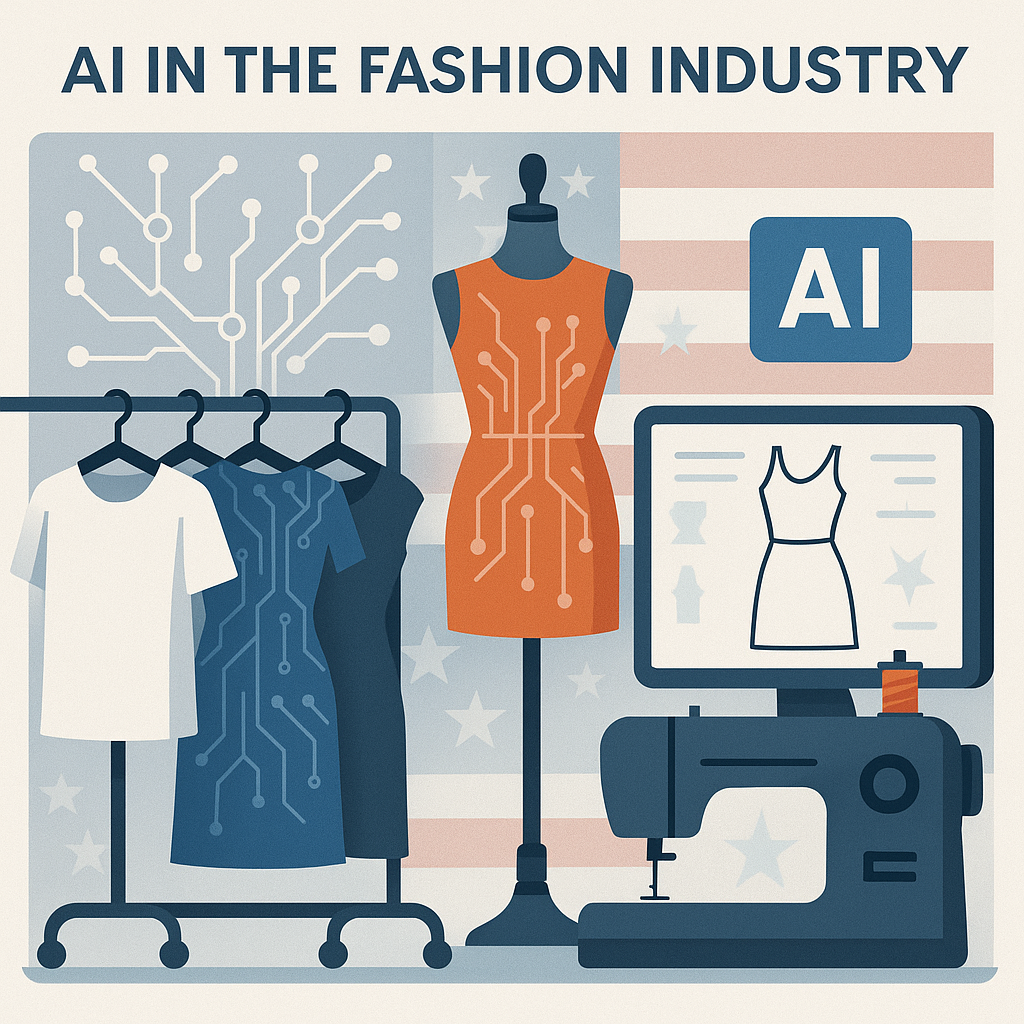
AI in the Fashion Industry: How Artificial Intelligence is Transforming U.S. Fashion in 2025
The fashion industry is experiencing a technological revolution, and at the heart of this transformation is artificial intelligence (AI). In 2025, AI in the fashion industry is not just a buzzword—it’s a driving force behind innovation, efficiency, and creativity. From design to retail, AI is reshaping how brands operate and how consumers experience fashion in the United States.
The Rise of AI in the Fashion Industry: 2025 Trends and Insights
AI has become integral to the U.S. fashion landscape, powering everything from predictive analytics to virtual fitting rooms. Let’s explore the key trends and applications that define AI in the fashion industry today.
🏆 Top 10 Applications of AI in the Fashion Industry (2025)
- Personalized Shopping Experiences
- Inventory Management and Demand Forecasting
- AI-Powered Design and Trend Prediction
- Virtual Try-Ons and Fitting Rooms
- Automated Customer Service (Chatbots)
- Visual Search and Image Recognition
- Supply Chain Optimization
- Sustainable Fashion Initiatives
- Fraud Detection and Loss Prevention
- Social Media and Influencer Analytics
Side-by-Side Comparison Table: AI Applications in U.S. Fashion
| Rank | Application | Key Benefit | Example Use Case |
|---|---|---|---|
| 1 | Personalized Shopping Experiences | Boosts customer loyalty | AI-driven product recommendations |
| 2 | Inventory Management & Forecasting | Reduces overstock/shortages | Predictive analytics for stock |
| 3 | AI-Powered Design & Trend Prediction | Accelerates design process | Generative design tools |
| 4 | Virtual Try-Ons & Fitting Rooms | Enhances online shopping | AR-powered fitting apps |
| 5 | Automated Customer Service | 24/7 support, cost savings | AI chatbots for FAQs |
| 6 | Visual Search & Image Recognition | Improves product discovery | Search by photo |
| 7 | Supply Chain Optimization | Increases efficiency | Route optimization |
| 8 | Sustainable Fashion Initiatives | Reduces waste, eco-friendly | AI for material selection |
| 9 | Fraud Detection & Loss Prevention | Protects revenue | AI monitoring transactions |
| 10 | Social Media & Influencer Analytics | Informs marketing strategy | AI tracks influencer ROI |
TIP: Brands that embrace multiple AI applications often see the greatest competitive advantage in the U.S. market.
How AI is Revolutionizing Fashion Design and Trend Prediction
AI is empowering designers and brands to stay ahead of the curve by analyzing massive datasets—from runway shows to social media trends. Generative AI tools can create new patterns, suggest color palettes, and even design entire collections based on consumer preferences.
Example: AI-Generated Fashion Sketch
Input: "Spring 2025, sustainable streetwear, pastel colors"
AI Output: [Digital sketches with pastel colorways, eco-friendly materials, and urban silhouettes]
TIP: AI-generated designs can be rapidly prototyped, reducing time-to-market and minimizing costly design errors.
Personalized Shopping: AI’s Impact on the U.S. Consumer Experience
AI-driven personalization is transforming how Americans shop for fashion. Machine learning algorithms analyze browsing history, purchase patterns, and even social media activity to recommend products tailored to individual tastes.
Key Features of AI-Powered Personalization
- Dynamic Product Recommendations
- Personalized Email Campaigns
- Customizable Virtual Stylists
TIP: Personalized experiences lead to higher conversion rates and increased customer satisfaction.
Virtual Try-Ons and Augmented Reality: The Future of Online Fashion
With the rise of e-commerce, virtual try-ons powered by AI and augmented reality (AR) are bridging the gap between physical and digital shopping. Shoppers can see how clothes fit and look on their own bodies using smartphone cameras or smart mirrors.
Sample Code: Integrating an AI Virtual Try-On API
import ai_fashion_sdk
user_image = ai_fashion_sdk.upload_image("user_photo.jpg")
selected_item = ai_fashion_sdk.select_item("SKU12345")
virtual_tryon = ai_fashion_sdk.try_on(user_image, selected_item)
ai_fashion_sdk.display(virtual_tryon)
TIP: Virtual try-ons reduce return rates and boost consumer confidence in online purchases.
AI in Fashion Retail: Inventory, Supply Chain, and Sustainability
AI is optimizing inventory management and supply chain logistics, helping U.S. retailers minimize waste and respond quickly to changing demand. Predictive analytics ensure the right products are in stock at the right time, while AI-driven sustainability initiatives help brands make eco-friendly choices.
Benefits of AI for Retailers
- Accurate Demand Forecasting
- Automated Reordering
- Sustainable Material Sourcing
TIP: AI-powered sustainability tools can analyze the environmental impact of materials and suggest greener alternatives.
AI-Driven Marketing: Social Media, Influencers, and Visual Search
Fashion brands are leveraging AI to analyze social media trends, track influencer performance, and enable visual search capabilities. AI tools can identify emerging styles, measure campaign ROI, and let consumers search for products using images instead of keywords.
Example: AI Social Media Trend Analysis
# Pseudocode for AI trend detection
import ai_trend_analyzer
hashtags = ai_trend_analyzer.fetch_trending_hashtags("fashion")
trend_report = ai_trend_analyzer.analyze(hashtags)
ai_trend_analyzer.display_report(trend_report)
TIP: AI-powered analytics help brands make data-driven marketing decisions and stay ahead of competitors.
Challenges and Considerations for AI in the Fashion Industry
While AI offers immense benefits, it also presents challenges such as data privacy, algorithmic bias, and the need for skilled talent. U.S. fashion brands must address these issues to ensure ethical and effective AI adoption.
Key Challenges
- Data Security and Privacy
- Bias in AI Algorithms
- Integration with Legacy Systems
- Talent Shortage in AI and Data Science
TIP: Regular audits and transparent AI practices help build consumer trust and regulatory compliance.
Conclusion: The Future of AI in the Fashion Industry
AI in the fashion industry is revolutionizing every aspect of the U.S. market in 2025. From personalized shopping and AI-powered design to sustainable supply chains and advanced marketing analytics, artificial intelligence is driving unprecedented innovation and efficiency. Brands that strategically invest in AI technologies are better equipped to meet evolving consumer demands, reduce operational costs, and stay ahead in a highly competitive landscape.
As AI continues to evolve, its role in fashion will only grow, offering new opportunities for creativity, sustainability, and customer engagement. The future of fashion in the United States is undeniably intelligent, data-driven, and customer-centric—thanks to the transformative power of AI.